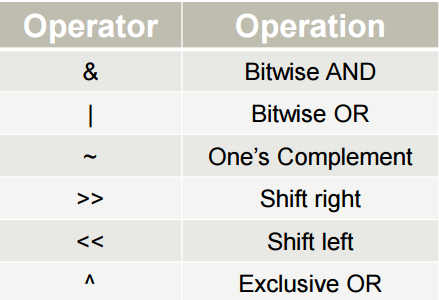Bitwise operators are a concept that deals with levels of individual bits. In the early days of computers, memory was very expensive and computers did not have much of it. You must have some idea of how integers are represented in binary. For example, the decimal number 3 is represented as 11 in binary. Likewise, the decimal number 5 is represented as 101 in binary. If you ever do any programming with hardware in C++, it can be a very handy concept to understand.
In the table below are the 6-bit manipulation operators which you can use
Run through the example code of bitwise operators. Go through each one to understand which bitwise operation is running for each one.
#include <iostream>
using namespace std;
int main()
{
unsigned int a = 60; // 60 = 0011 1100
unsigned int b = 13; // 13 = 0000 1101
int c = 0;
c = a & b; // 12 = 0000 1100
cout << "Line 1 - Value of c is : " << c << endl ;
c = a | b; // 61 = 0011 1101
cout << "Line 2 - Value of c is: " << c << endl ;
c = a ^ b; // 49 = 0011 0001
cout << "Line 3 - Value of c is: " << c << endl ;
c = ~a; // -61 = 1100 0011
cout << "Line 4 - Value of c is: " << c << endl ;
c = a << 2; // 240 = 1111 0000
cout << "Line 5 - Value of c is: " << c << endl ;
c = a >> 2; // 15 = 0000 1111
cout << "Line 6 - Value of c is: " << c << endl ;
return 0;
}
Share this post



